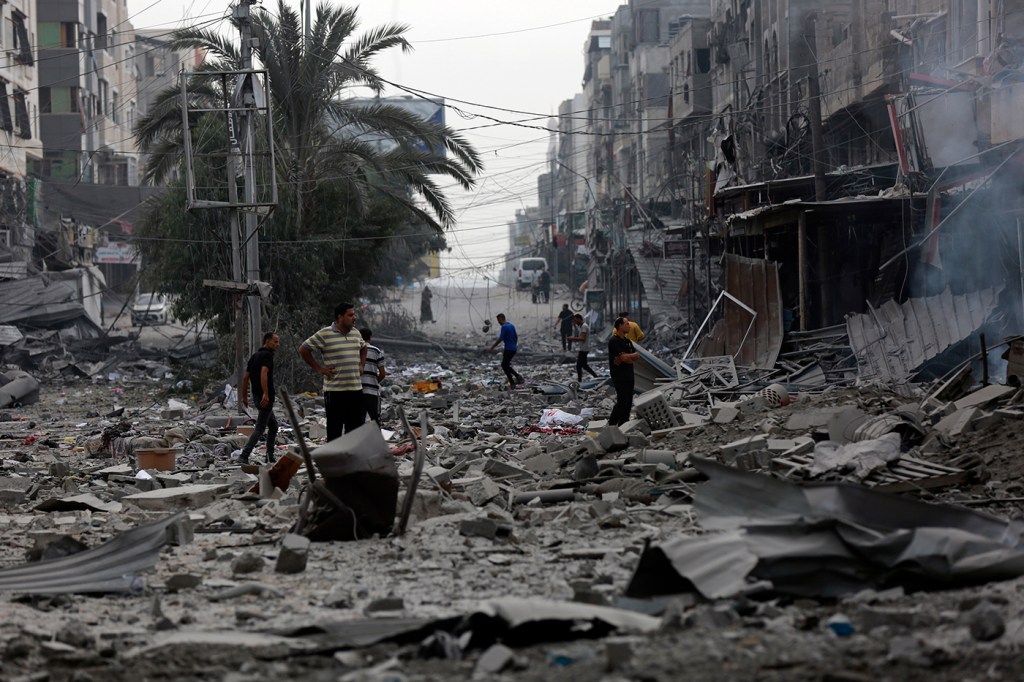Experts on disinformation talk Israel-Hamas: It’s a ‘toxic stew of an information environment’

This report is part of ongoing coverage of the Israel-Hamas war. Visit our dedicated page for more on this topic.
After Hamas’ Oct. 7 surprise attack on Israel, observers quickly highlighted the deluge of disinformation and misinformation circulating over social media.
In the days and weeks following the attack, the rapid inflow of images, videos and other raw sources of information — coupled with statements from the warring parties — influenced the headlines of major newspapers to problematic effects, prompting several outlets to issue apologies about aspects of their coverage, or further clarifications of early reports.
The bombing of a hospital in Gaza on Oct. 17 is just one example — as both sides blamed the other, news outlets ran reports without all of the facts.
Experts say that is because news agencies and fact-checkers covering the war are under extreme pressure to produce timely reports, with little capacity to verify claims. It’s just one of the many challenges of covering a war in the social media age.
“The key thing here is this kind of time sensitivity,” says Brian Ball, head of faculty and associate professor in philosophy at Northeastern University London.
Ball’s research has focused on the ways knowledge flows in social media communities. He says that, in addition to the usual stream of misinformation, both sides in the conflict are incentivized to bend the truth in their favor.
“There’s a different kind of game going on here, which is that there are parties and factions involved here who are actually invested in getting people to think the wrong things,” he says of the Israel-Hamas war.
Northeastern Global News also spoke at length with David Lazer, university distinguished professor of political science and computer sciences, about the issue.
We’ve posted the full exchange with Lazer, edited for brevity and clarity.
What problems have you observed with the way information about this war has moved from the authorities to the broader public?
There’s that old line that truth is the first casualty of war, and there are a bunch of reasons for that. There are powerful parties that have an interest in portraying what’s happening in a certain kind of way, and journalism can’t either match that capacity or doesn’t have the time to come up with answers.
I mean the whole hospital episode is an interesting example in that it’s still somewhat ambiguous — that is, we don’t know what happened exactly. Maybe at some point we’ll gather all of the facts and come to a determination that’s persuasive; but, as it happened, many outlets rapidly reported out headlines stating one thing, then they gradually rolled it back; then they had another conclusion that has now — it appears — been contradicted by further analysis of the video, etcetera etcetera.
The authoritative sources of information have enormous incentives to distort, and journalists just don’t have the capacity to gather facts quickly and in a high-quality way, so very incomplete things get reported that are often statements from the warring parties. At the same time you have lots of people who have strong opinions on the topic who are willing to share content that fits with their prior views — even if it’s questionable. All of that makes for a toxic stew of an information environment.
Does it seem like there’s an additional layer of ambiguity in this conflict compared to say, the situation in Ukraine? There the framing appears clear: it’s Vladimir Putin vs. the West. But in the Israel-Hamas war, are there additional sensitivities of framing — e.g., not conflating Hamas with Palestinian civil society, or the debate over proportionate response — that fuels the information war?
What’s happening with Israel and Hamas is just more vigorously contested, certainly in U.S. media. By that I mean, in terms of mainstream opinion, it’s a more contested information environment. I’m trying to figure out how to put this, but there’s sort of a metastory — the story about the story — which is the story about people’s reactions to the war, which exists to some extent in Ukraine.
But there’s an extraordinary set of layers of stories about speech and opinions and facts that we see certainly on campuses, but also more broadly in U.S. society, about the story in the Middle East; that’s not to say it hasn’t also been there with Ukraine — but it has not been as prominent in my view.
What oversight exists for disinformation and misinformation online? In other words, who is responsible for reining in all of this bad information?
Well, there really isn’t much. I mean there are some places: the EU has some capacity, and took some steps to confront X on some of these issues. But generally, the pattern is still such that the platforms govern themselves, and then those of us on the outside yell at them to change things or do better — often to mixed results. Sometimes they respond — and often they don’t.
That has been what’s described as the “governance model.” That is, the platforms make decisions on how to govern the commons, and then they are subject to external critique, but without any real regulatory intervention.
On a final note, with the hate crimes we’ve seen here in the U.S. and elsewhere seemingly in response to the war, do you see a link between those acts and any of the disinformation spreading online?
It’s a good question, and the answer is: I don’t know. This is going to sound really nerdy of me, but we don’t know what the counterfactual is. The counterfactual isn’t a world in which people don’t say hateful things and do hateful things. I mean, people have done terrible things before, and there was lots of violence and prejudice before the internet was around.
Of course there will be people who see terrible things online and act terribly, but it’s hard to attribute that to the internet and, more specifically, the social platforms. It’s a hard question, and we don’t have a control group.
Many things in the world have changed since, say, the late ’90s when the internet started to become a mass phenomenon; but before the late ’90s, there was plenty of racism and antisemitism and anti-Arab sentiment, and lots of examples of people getting killed.
Tanner Stening is an assistant news editor at Northeastern Global News. Email him at t.stening@northeastern.edu. Follow him on X/Twitter @tstening90.





